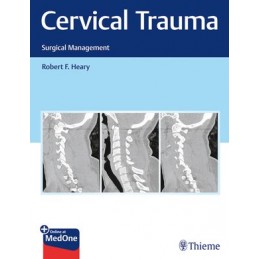- Reduced price

Order to parcel locker

easy pay


 Delivery policy
Delivery policy
Choose Paczkomat Inpost, Orlen Paczka, DHL, DPD or Poczta Polska. Click for more details
 Security policy
Security policy
Pay with a quick bank transfer, payment card or cash on delivery. Click for more details
 Return policy
Return policy
If you are a consumer, you can return the goods within 14 days. Click for more details
The definitive textbook on the management of cervical spine trauma from master spine surgeons!
Understanding the clinical implications of cervical trauma requires thorough knowledge of the anatomy and physiology of the cervical spine. Cervical Trauma:: Surgical Management by renowned spine surgeon Robert Heary and a cadre of prominent neurosurgical and orthopaedic spine experts is the most comprehensive, state-of-the-art resource available to date on this topic. The text begins with discussion of cervical anatomy and the pathophysiology of spinal cord injury (SCI), SCI classification systems, initial assessments in patients with cervical SCIs, and cranioskeletal traction, followed by injury-specific chapters.
Classification systems and management protocols developed over the last 40 years have enabled spine surgeons to work collaboratively with specialists in trauma surgery and critical care to provide optimal management of SCIs and attain improved long-term patient outcomes. This book covers a full spectrum of trauma-related conditions impacting the cervical spine and multidisciplinary interventions including minimally invasive surgery, neurointerventional techniques, reconstructive therapy with bone grafts or alternative stabilization methods, evidence-based medications, and SCI rehab.
Key Highlights
Neurosurgical and orthopaedic residents, veteran spine surgeons, and allied healthcare practitioners who treat patients with traumatic cervical spine conditions will benefit from reading this outstanding resource, cover-to-cover. It also provides an ideal go-to reference to consult in the ER when patients present with cervical trauma.
This book includes complimentary access to a digital copy on https://medone.thieme.com.
Data sheet
1 Anatomy of the Cervical Spine
2 Classification of Spinal Cord Injury
3 Pathophysiology of Spinal Cord Injury
4 Initial Assessment (Including Imaging) of Cervical Spinal Cord Injury
5 Cranioskeletal Traction for the Management of Trauma to the Cervical Spine
6 Atlanto-occipital Injuries
7 Odontoid and Hangmans Fractures
8 Management of Traumatic Atlantoaxial Subluxations
9 Traumatic Atlantoaxial Rotatory Fixation
10 Subaxial Cervical Trauma in the Adult Patient
11 Subaxial Cervical Spine Trauma in the Pediatric Patient
12 Cervical Burst Fractures
13 Cervical Spine Trauma-Induced Vertebral Artery Injury
14 Sport-Related Cervical Spine Injuries and Return-to-Play Criteria
15 Craniovertebral Injuries in Pediatric Patients
16 Penetrating Injuries to the Cervical Spine
17 Cervical Spine Trauma in Patients with Congenital Spinal Stenosis
18 Trauma in Patients with Rheumatoid Arthritis of the Cervical Spine
19 Traumatic Cervical Myelopathy
20 Minimally Invasive Spine Surgery
21 Role of Neurointerventional Techniques in Cervical Trauma
22 Bone Graft Options, Substitutes, and Harvest Techniques
23 Non-operative Management and Treatment of Cervical Spine Injuries
24 Rehabilitation after Spinal Cord Injury: Approaches and Caveats
25 Clinical Trials Update: Where Do We Go From Here?
26 Pharmacologic Treatment of Spinal Cord Injury
